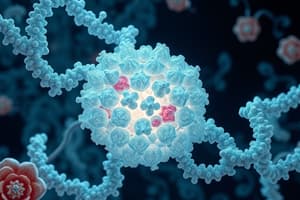Podcast
Questions and Answers
Why is glycogen a more advantageous form of carbohydrate storage compared to free-floating glucose?
Why is glycogen a more advantageous form of carbohydrate storage compared to free-floating glucose?
- Storing glucose as glycogen prevents excessive osmotic pressure within the cell. (correct)
- Glycogen directly enters the bloodstream, bypassing cellular metabolism.
- Glycogen is more readily available for immediate energy use.
- Free-floating glucose is more stable and less prone to degradation.
Which of the following is NOT a primary location for glycogen synthesis and storage in the body?
Which of the following is NOT a primary location for glycogen synthesis and storage in the body?
- Kidney
- Brain (correct)
- Skeletal Muscle
- Liver
What is the primary function of muscle glycogen?
What is the primary function of muscle glycogen?
- Synthesizing hormones for systemic distribution.
- Serving as an energy reserve specifically for muscle contraction. (correct)
- Detoxifying harmful substances in the bloodstream.
- Maintaining blood glucose levels during fasting.
In glycogen synthesis, what is the role of glycogenin?
In glycogen synthesis, what is the role of glycogenin?
Why is glycogen branching important?
Why is glycogen branching important?
What type of glycosidic bond does glycogen phosphorylase act on?
What type of glycosidic bond does glycogen phosphorylase act on?
Which of the following statements accurately describes the function of the debranching enzyme in glycogenolysis?
Which of the following statements accurately describes the function of the debranching enzyme in glycogenolysis?
In which scenario would glycogen breakdown in the liver be most critical?
In which scenario would glycogen breakdown in the liver be most critical?
What is the immediate product of glycogen phosphorylase activity?
What is the immediate product of glycogen phosphorylase activity?
What is the role of phosphoglucomutase?
What is the role of phosphoglucomutase?
If an individual has a genetic defect resulting in a non-functional branching enzyme, what would be the most likely consequence?
If an individual has a genetic defect resulting in a non-functional branching enzyme, what would be the most likely consequence?
During exercise, epinephrine stimulates glycogen breakdown in muscle. What is the primary purpose of this process?
During exercise, epinephrine stimulates glycogen breakdown in muscle. What is the primary purpose of this process?
What is a key characteristic of McArdle disease?
What is a key characteristic of McArdle disease?
Which of the following best describes the role of UDP-glucose pyrophosphorylase in glycogen synthesis?
Which of the following best describes the role of UDP-glucose pyrophosphorylase in glycogen synthesis?
How does the function of glycogen synthase differ from that of branching enzyme?
How does the function of glycogen synthase differ from that of branching enzyme?
If a patient is diagnosed with Von Gierke's disease (Type Ia), which enzyme is most likely deficient?
If a patient is diagnosed with Von Gierke's disease (Type Ia), which enzyme is most likely deficient?
What is the metabolic consequence of a deficiency in the debranching enzyme?
What is the metabolic consequence of a deficiency in the debranching enzyme?
In white (fast-twitch) muscle fibers, glucose is primarily converted to lactate. Why?
In white (fast-twitch) muscle fibers, glucose is primarily converted to lactate. Why?
How does the allosteric regulation of glycogen phosphorylase contribute to energy homeostasis?
How does the allosteric regulation of glycogen phosphorylase contribute to energy homeostasis?
Which of the following enzymes is unique to the liver and allows it to release free glucose into the bloodstream?
Which of the following enzymes is unique to the liver and allows it to release free glucose into the bloodstream?
Flashcards
What is glycogen?
What is glycogen?
Glycogen is a branched polymer of glucose and is the storage form of glucose in animals and humans.
Where does glycogen synthesis occur?
Where does glycogen synthesis occur?
Glycogen synthesis and degradation occur primarily in the liver and skeletal muscle.
Muscle glycogen's purpose?
Muscle glycogen's purpose?
In muscle cells, glycogen is stored as an energy reserve for muscle contraction.
Liver glycogen function?
Liver glycogen function?
Signup and view all the flashcards
How is glycogen stored?
How is glycogen stored?
Signup and view all the flashcards
Key Enzyme in Glycogen Synthesis?
Key Enzyme in Glycogen Synthesis?
Signup and view all the flashcards
Glycogen phosphorylase action?
Glycogen phosphorylase action?
Signup and view all the flashcards
Glycogen phosphorylase limitations?
Glycogen phosphorylase limitations?
Signup and view all the flashcards
Debranching enzyme function?
Debranching enzyme function?
Signup and view all the flashcards
McArdle disease
McArdle disease
Signup and view all the flashcards
Study Notes
- Glycogen is a branched polymer of glucose and acts as a storage form of glucose in the body
- Glycogen synthesis and degradation primarily occur in the liver and skeletal muscle, but can occur in other tissues, including cardiac muscle and the kidney, which store smaller quantities
- Storing carbohydrates as glycogen has many advantages in comparison to storing free-floating glucose
Glycogen Location and Structure
- Glycogen is stored in the cytoplasm as single granules in skeletal muscle or as clusters of granules in the liver
- Each granule is composed of a central protein core surrounded by polyglucose chains radiating outward in a spherical structure
- Liver glycogen serves as a source of glucose that is mobilized during hypoglycemia, aiding in maintenance of blood sugar levels
- Muscle glycogen acts as an energy reserve for muscle contraction
- In white (fast-twitch) muscle fibers, glucose turns primarily to lactate
- In red (slow-twitch) muscle fibers, glucose is completely oxidized
Glycogen Synthesis
- Glycogen synthesis (glycogenesis) and glycogen breakdown (glycogenolysis) are the 2 pathways involved in glycogen metabolism
- Glycogen synthesis starts with the core protein glycogenin, which helps begin the formation of glycogen granules
- Glucose in the form of glucose 6-phosphate gets turned into glucose 1-phosphate and activated to UDP-glucose
- UDP-glucose is added to glycogen chains by glycogen synthase
- Glycogen synthase is the rate-limiting enzyme in glycogen synthesis
Glycogenolysis
- Glycogen phosphorylase is the rate-limiting enzyme involved in glycogenolysis (glycogen breakdown)
- Glycogen phosphorylase is a phosphorlase, which breaks bonds using Pi rather than H20
- Glycogen phosphorylase breaks α-1,4 glycosidic bonds, releasing glucose 1-phosphate from the periphery of the granule
- The glucose 1-phosphate that is formed gets converted to glucose 6-phosphate by the mutase that is utilized in glycogen synthesis
Debranching Enzyme
- Debranching enzymes deconstruct glycogen branches that were already exposed by glycogen phosphorylase through 2 mechanisms:
- Breaking α-1,4 bonds adjacent to branch points and moving small oligoglucose chains that have been released to exposed ends of other chains, forming new α-1,4 bonds
- Hydrolyzing α-1,6 bonds, releasing single residues at the branch point as free glucose
Genetic Deficiencies
- Many genetic deficiencies of enzymes in glycogen metabolism have been classified as glycogen storage diseases
- Glycogen storage diseases are characterized by the accumulation of glycogen in one or more tissues
- McArdle disease mainly affects skeletal muscles and happens because of a deficiency or absence of myophosphorylase
- Symptoms include painful muscle cramps, weakness, and fatigue that occur during physical activity
Studying That Suits You
Use AI to generate personalized quizzes and flashcards to suit your learning preferences.



